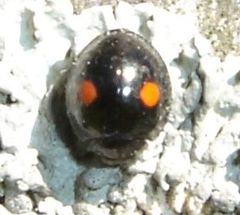- Chilocorus stigma
-
Chilocorus stigma Scientific classification Kingdom: Animalia Phylum: Arthropoda Class: Insecta Order: Coleoptera Family: Coccinellidae Genus: Chilocorus Species: C. stigma Binomial name Chilocorus stigma
(Say, 1835)Chilocorus stigma, commonly known as the twice-stabbed lady beetle, is a native resident of the United States and Canada but does not live west of the Sierra Nevada. The two-stabbed lady beetle Chilocorus orbus is a found widespread in California.[1]. It also lives in Oceania and has been introduced to Hawaii [2]. Its elytra are shiny black in color, and there is one red spot on each elytra. The remainder of the body is black as well, but the abdomen is either yellow or red in color.
Contents
Habitat and pests eaten
C. stigma mainly lives within terrestrial/arboreal habitats, primarily feeding of aphids found in these habitats as well as scales (such as pine needle scale, beech bark scale and Florida red scale) and mealybugs. It is a beneficial insect, and is useful in both natural wood stands and commercial forests such as orchards and citrus groves. It is beneficial against non native species. An introduced Hemlock pest, the elongate hemlock scale (Fiorinia externa Ferris), which has been doing considerable damage to Hemlock trees throughout North America, can be moderately controlled by the presence of C. stigma [3]. C. stigma is currently not a lady beetle that can be sold for commercial use in orchards or on farms.
Life cycle and issues
C. stigma usually completes two lifecycles a year in Canada and the North United States but may complete several lifecycles a year further down South. They overwinter in ground litter during the colder months. C. stigma has been shown, like other ladybeetles, to be susceptible to the use of insecticides diminishing its population in the wild. In order to preserve the benefits of this insect, pesticide users are encouraged to use natural alternatives to pesticide in order to curb the decline of C. stigma.
Chromosomal polymorphism
The chromosome number (karyotype) of Chilocorus stigma varies from one individual to another. This is an example of chromosomal polymorphism;[4] the variability occurs as a result of chromosome fusions or disassociations.[5]
Morphisms are extremely common in lady beetles. They are certainly maintained by selection, but the basis of the selection is not yet understood.[6]
External links
References
- ^ Template:California Insects, Powell & Hogue, university of California PRess, 1979. p. 299
- ^ "Chilocorus stigma". Integrated Taxonomic Information System. http://www.itis.gov/servlet/SingleRpt/SingleRpt?search_topic=TSN&search_value=114345. Retrieved 30 April 2006.
- ^ United States Department of Agriculture. "Elongate hemlock scale". http://www.na.fs.fed.us/spfo/pubs/pest_al/ehscale/ehscale.htm. Retrieved 30 April 2006.
- ^ Polymorphism: when two or more clearly different phenotypes exist in the same interbreeding population of a species. Ford E.B. 1975. Ecological genetics, 4th ed.
- ^ White M.J.D. 1973. The chromosomes. Chapman & Hall, London. p169
- ^ Brakefield P.M. 1985. Polymorphic Müllerian mimicry and interactions with thermal melanism in ladybirds and a soldier beetle—a hypothesis. Biological J. Linnaean Soc. 26, 243-267.
Categories:- Coccinellidae
- Biological pest control agents
Wikimedia Foundation. 2010.

